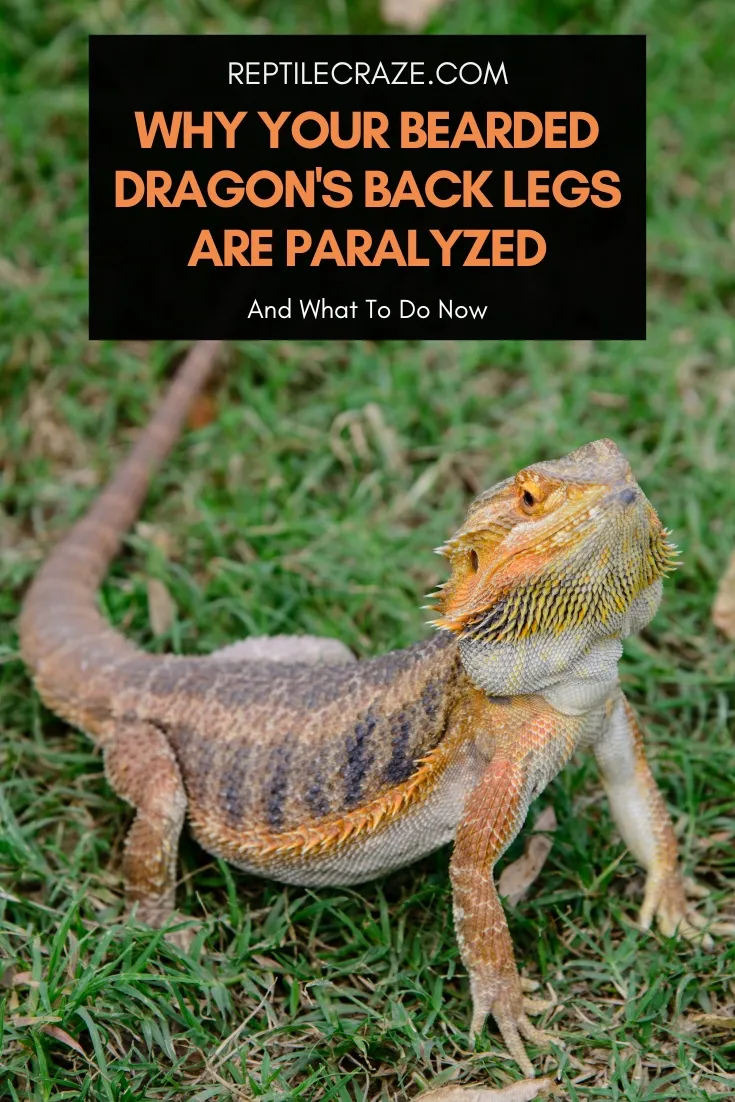
Bearded dragons are a favorite among reptile enthusiasts because of their docile nature and unique appearance. However, they can face several health issues, one of the most common of which is the paralysis of their back legs.
Paralysis in bearded dragons’ back legs is caused by a variety of conditions, including metabolic bone disease, injury, nutritional problems, dehydration, constipation, gout, and egg binding. Immediate veterinary attention is critical to arrive at a diagnosis, ease the pain, and aid in recovery.
By understanding the potential causes and associated symptoms related to limb paralysis, you can be more aware of your pet’s well-being. Here, we give an overview on common reasons why your bearded dragon’s back legs may be paralyzed.
Table of Contents
What Does Leg Paralysis Look Like on My Bearded Dragon?
Leg paralysis in bearded dragons can present in several ways, but the most common symptom is difficulty moving or an inability to use the back legs.
Your bearded dragon won’t be walking right, and the hindlimbs may be stretched out and swollen.
A bearded dragon with paralysis may drag their hindquarters or limp, and may be unable to climb or jump as they usually would.
In severe cases, the back legs will be completely immobile and they may be unable to move at all. The same paralysis can also affect the front legs.
In addition to difficulty moving, a bearded dragon with leg paralysis may also experience inappetence, weight loss, lethargy, or other signs of illness.
These accompanying symptoms may vary depending on the underlying cause of the paralysis.
What Are The Causes of Back Leg Paralysis in Bearded Dragons?
Understanding the potential causes of paralysis is crucial to directly addressing the problem and assessing the severity of the condition. Here are some common causes of back leg paralysis in bearded dragons:
Metabolic Bone Disease
Metabolic bone disease (MBD) is a common condition among captive reptiles that causes bone weakness and deformities.
The most common type of MBD is a condition known as nutritional secondary hyperparathyroidism (NSHP).
NSHP is caused by a diet poor in calcium, vitamin D3, and inadequate exposure to UVB lighting. Reptiles need Vitamin D3, which they get from their
Without enough calcium, the bones become weak and brittle, leading to fractures and health issues. In severe cases, MBD and NSHP can result in paralysis of the back legs.
NSHP commonly occurs in herbivorous and insectivorous reptiles like the bearded dragon, as well as in rapidly growing young animals and female reptiles during breeding season due to their body’s increased demand for calcium.
Aside from leg paralysis, other signs of MBD and NSHP are the following:
- Swollen back legs
- Abnormal kinking and deviations in the spine and tail
- Difficulty lifting the body off the ground, resulting in a swimming movement.
- Tremors, seizures, or jerky movements of the legs and head
- A swollen or rubbery jaw, with lips drooping down to expose the gums
Trauma and Fractures
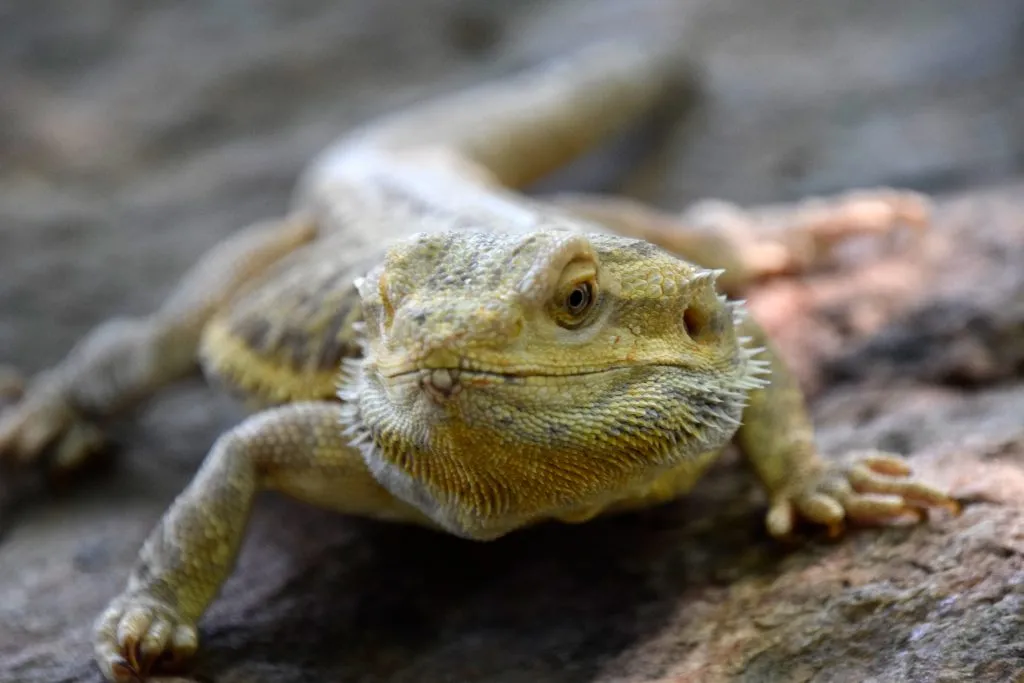
Physical trauma is a common cause of leg paralysis. It can result from accidental falls, improper handling, and attacks by other reptiles or animals.
Bearded dragons are generally solitary lizards, and they prefer to be housed alone. Introducing another reptile or lizard to their enclosure can lead to unwanted violence, especially with territorial males.
When they fight, bearded dragons pack a strong bite that can induce serious physical damage.
Nerve Injury
Injuries to the spinal cord or nerves can cause paralysis in bearded dragons. This can result from falls, fights with other animals, or other types of accidents.
Malnutrition and improper management can also cause diseases affecting the nerves in reptiles like bearded dragons.
Symptoms of trauma-related paralysis may not appear immediately, as it can take time for swelling and inflammation to affect nerve function.
The severity of the symptoms and the body parts affected also depend on which nerves have been damaged.
For back leg paralysis, injury of the peripheral nerves at the lumbar and leg area, such as the sciatic, femoral, peroneal, and tibial nerves, are likely culprits.
Other signs of nerve damage include seizures, head tilt, and looking upwards or “stargazing”.
In worse cases, nerve injury can be quite deadly to your bearded dragon. Your bearded dragon may lose the ability to carry out everyday tasks on their own, such as pooing and peeing.
They may lose their sensation, and sadly they can end up having a poor quality of life.
Constipation
Constipation or impaction is another common condition among captive bearded dragons. It occurs when bowel movements become irregular and the reptile has difficulty passing stool.
Constipation can be caused by a variety of factors, such as ingesting foreign objects, a lack of water in the diet, parasites, infection, and muscle or nerve weakness.
Impaction is a common consequence of improper substrate in the enclosure. Loose particles such as sand can stick to your bearded dragon’s
Another common cause of constipation is a urate plug obstruction. Bearded dragons have only one opening to pass their stool and urine, called the cloaca or vent.
Urine is released as a semi-solid substance containing uric acid salts and water. Sometimes, these salts can block the vent opening causing impaction.
Constipated animals will usually lose their appetite and become lethargic. If left untreated, impaction can cause nerve damage and lead to paralysis in the back legs.
Dehydration
Dehydration can cause a variety of health issues in bearded dragons, and in severe conditions, it can lead to paralysis.
Other Signs of dehydration include sunken eyes, lethargy, and dry, wrinkly, loose skin. If it’s shedding season, a dehydrated reptile retains much of its shed.
A quick way to assess if your bearded dragon is dehydrated is to perform the skin turgor test. Gently pinch and lift a section of loose skin at the back or side of the animal so that it forms a tent.
Release the skin, and assess how long it takes for the skin to go back to its original place.
It should only take 1 to 2 seconds for a hydrated animal, and longer for a dehydrated bearded dragon.
Kidney Disease
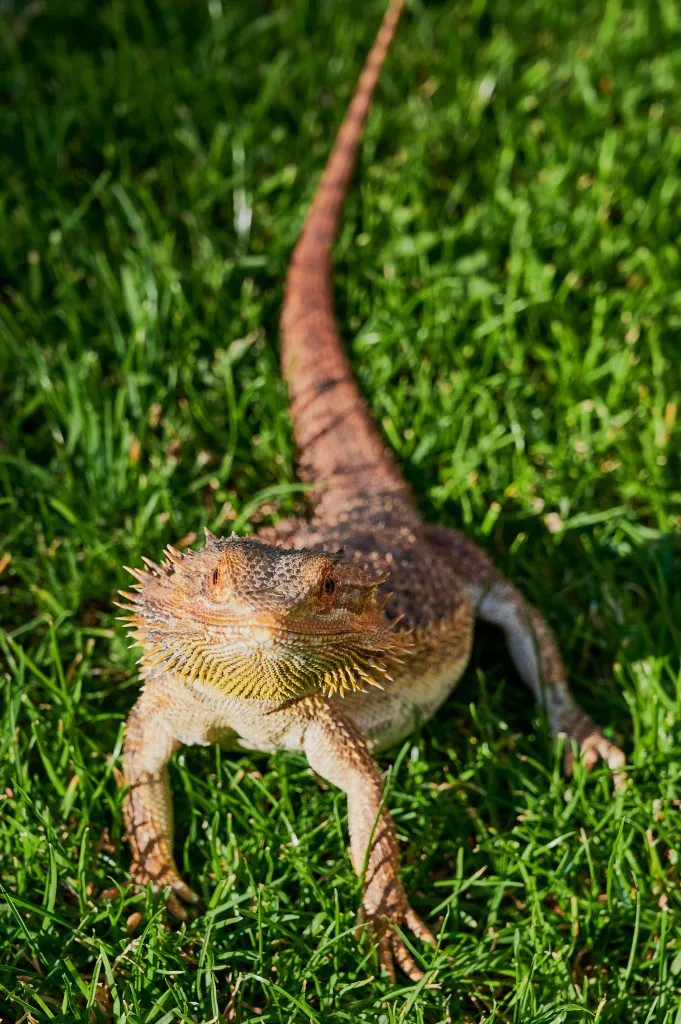
Chronic dehydration can lead to kidney failure, which is a common result of long-term improper management of your reptiles.
Continuous exposure to low humidity, lack of water, a high protein diet, and excess vitamin D supplementation are some of the many causes that lead to chronic kidney failure.
The early signs of kidney disease include a lack of appetite, lethargy, and sunken eyes.
As it progresses, your bearded dragon may emit a foul, rotting odor, have blood-shot eyes, and necrosis at the most distal extremities such as the tail and fingers may start when the blood circulation becomes insufficient.
Paralysis and weakness in the hind limbs can be observed in lizards suffering from kidney failure. They may also limp on one or both sides, demonstrating a wheelbarrow gait.
In very advanced stages, they vomit or regurgitate food when fed.
Chronic kidney failure is a very difficult condition for bearded dragons, as it is very painful and affects their overall quality of life.
Most bearded dragons do not live long. The good news is that kidney disease is easily preventable by implementing good management and husbandry.
Gout and Pseudogout
Gout occurs when there is an excessive amount of uric acid in the blood. This leads to the urate crystals being deposited in the tissues or joints, such as joints around the legs, which thus leads to paralysis of the back legs.
Pseudogout is similar to gout, but calcium deposits are involved. Joint deposits or articular gout are usually the early signs before progression to visceral gout.
The formation of these excess crystals is typically due to feeding a high-protein diet, chronic dehydration, and kidney failure.
Aside from back leg paralysis, reptiles with gout can develop swollen legs with nodules on the toes or ribs.
They will also become weak, depressed, emaciated, dehydrated, and unwilling to move and eat. The mouth can accumulate urate tophi, which are cream-colored uric acid deposits.
Egg Binding in Female Bearded Dragons
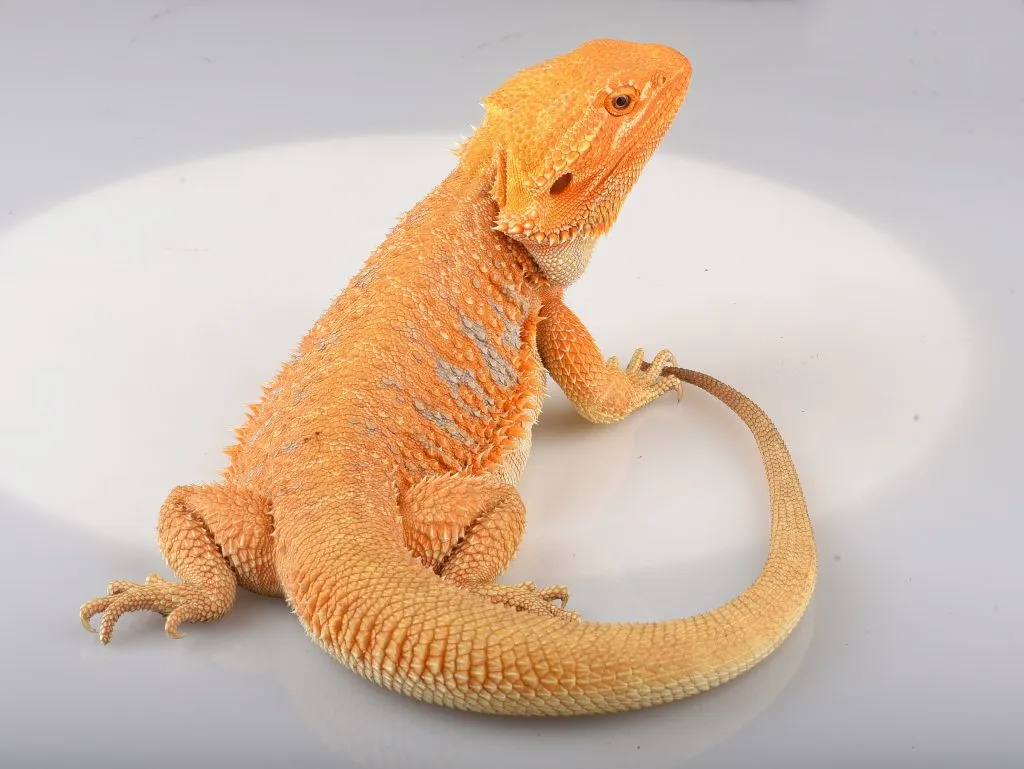
In reptiles, dystocia is also known as egg binding or ovostasis. This is the most common reproductive problem among females and refers to the difficulty in laying eggs.
Dystocia can be caused by an improper environment, inadequate UV lighting, improper temperature and humidity, infection, constipation, and abnormality in the development of the eggs.
Dystocia can be deadly to the mother and young if not immediately attended to. Symptoms include a back leg paralysis, lethargy, loss of appetite, and swelling around the cloaca.
What Should I Do When My Bearded Dragon’s Back Legs Are Paralyzed?
Most, if not all cases of back leg paralysis require immediate veterinary attention by your herp vet to diagnose the underlying condition, assess the severity, and give the proper treatment necessary.
Physical Examination
Your vet will interview you to get a detailed history of your bearded dragon, before proceeding to perform a physical examination.
They will check for apparent signs of unwellness such as sunken eyes, swollen limbs, and urate plugs on the vent.
The vet will also examine your bearded dragon’s gait and movement and palpate various body parts including the legs, stomach, and back.
To rule out nerve injury, a neurologic examination is frequently performed to try to isolate which groups of nerves are affected, if your bearded dragon is experiencing pain or a loss of sensation, and if they can still carry out norma day-to-day activities.
Diagnostic Tests
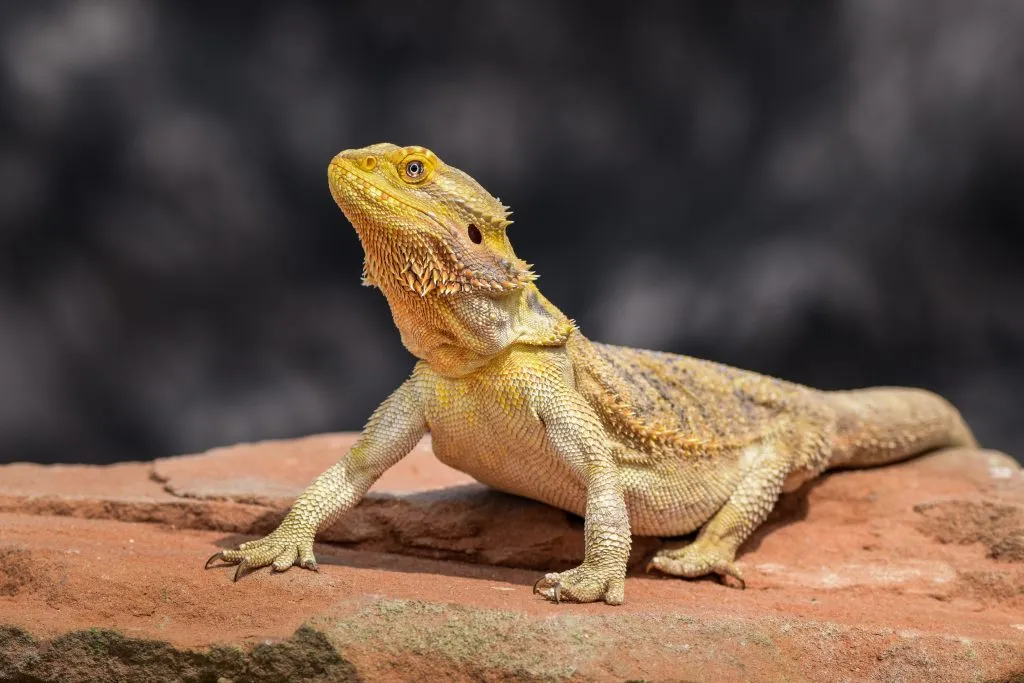
Based on what is found from the physical examination, your vet may suggest a battery of tests to run on your bearded dragon to arrive at a diagnosis.
Diagnostic imaging such as x-ray and ultrasound can help confirm whether your bearded dragon has a fracture, constipation, egg binding, and other issues.
Blood tests are also typically recommended to assess your beardie’s overall health. A complete blood count can show if a reptile is dehydrated, suffering from an infection or is stressed.
Blood chemistry tests can confirm if your bearded dragon has kidney failure, and how bad.
Calcium, phosphorous, and uric acid can also be measured in the blood to determine the presence of a metabolic bone disease or gout.
Treatment
Your vet will recommend changes in your husbandry and management that will be beneficial to your bearded dragon.
They will administer and prescribe the necessary medications that will help your bearded dragon feel better and recover. In some cases like fractures and egg binding, surgery may need to be done.
How to Prevent Back Leg Paralysis in Bearded Dragons?
Most of the causes of back leg paralysis can be avoided by having good husbandry and care for your bearded dragon. Here are some ways to prevent musculoskeletal problems:
- Balanced Diet: A healthy diet is key to preventing metabolic bone disease. Make sure your bearded dragon’s diet includes a variety of calcium-rich foods, such as dark leafy greens and calcium and vitamin D3 supplements.
- Adequate Lighting: Bearded dragons require access to full-spectrum UVB lighting (290-300 nm). Make sure that your bearded dragon’s enclosure has a UVB light source available for 10-12 hours daily. (We show you the best UVB bulbs here)
- Proper Handling: Knowing how to safely hold your bearded dragon can help prevent accidents that lead to injury. You should use one hand to fully support the body, with the fingers gently curved over its back. Do not pick them up by their tails or limbs.
- Optimum Enclosure: Bearded dragons need a large, spacious enclosure to exercise. They should have enough space to move around and enrichment items (like these) to “play” with to maintain good muscle tone, which helps in defecating and laying eggs.
- Adequate Hydration: Ensure that your bearded dragon always has access to clean water in a water bowl. Soaking your lizard in lukewarm, shallow water for at least 30 minutes can also address dehydration and constipation problems.
- Enchi Ball Python: A Unique and Stunning Morph of Python regius - March 27, 2025
- Emerald Tree Monitor: The Enigmatic Green Guardian of the Rainforest - March 26, 2025
- The Egyptian Cobra (Naja haje): A Fascinating Serpent - March 25, 2025
